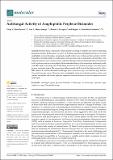Por favor, use este identificador para citar o enlazar a este item:
http://hdl.handle.net/10261/295473COMPARTIR / EXPORTAR:
 SHARE SHARE
 CORE
BASE CORE
BASE
|
|
| Visualizar otros formatos: MARC | Dublin Core | RDF | ORE | MODS | METS | DIDL | DATACITE | |

| Campo DC | Valor | Lengua/Idioma |
|---|---|---|
| dc.contributor.author | Roa-Linares, Vicky C. | - |
| dc.contributor.author | Mesa-Arango, Ana C. | - |
| dc.contributor.author | Zaragozá, Ramón José | - |
| dc.contributor.author | González-Cardenete, Miguel A. | - |
| dc.date.accessioned | 2023-02-21T12:00:12Z | - |
| dc.date.available | 2023-02-21T12:00:12Z | - |
| dc.date.issued | 2022-10-14 | - |
| dc.identifier | doi: 10.3390/molecules27206890 | - |
| dc.identifier | issn: 1420-3049 | - |
| dc.identifier.citation | Molecules 27(20): 6890 (2022) | - |
| dc.identifier.uri | http://hdl.handle.net/10261/295473 | - |
| dc.description.abstract | Perylene-based compounds, either naturally occurring or synthetic, have shown interesting biological activities. In this study, we report on the broad-spectrum antifungal properties of two lead amphiphilic perylene bisimides, compounds 4 and 5, which were synthesized from perylene-3,4,9,10- tetracarboxylic dianhydride by condensation with spermine and an ammonium salt formation. The antifungal activity was evaluated using a collection of fungal strains and clinical isolates from patients with onychomycosis or sporotrichosis. Both molecules displayed an interesting antifungal profile with MIC values in the range of 2¿25 uM, being as active as several reference drugs, even more potent in some particular strains. The ammonium trifluoroacetate salt 5 showed the highest activity with a MIC value of 2.1 uM for all tested Candida spp., two Cryptococcus spp., two Fusarium spp., and one Neoscytalidium spp. strain. Therefore, these amphiphilic molecules with the perylene moiety and cationic ammonium side chains represent important structural features for the development of novel antifungals. | - |
| dc.description.sponsorship | This study was supported by grant 201680I008 (awarded to M.A.G.-C.) from the Spanish Government (Consejo Superior de Investigaciones Científicas) and grant 3756 of the University of Antioquia. | - |
| dc.language | eng | - |
| dc.publisher | Molecular Diversity Preservation International | - |
| dc.relation.isversionof | Publisher's version | - |
| dc.rights | openAccess | - |
| dc.title | Antifungal Activity of Amphiphilic Perylene Bisimides | - |
| dc.type | artículo | - |
| dc.identifier.doi | 10.3390/molecules27206890 | es_ES |
| dc.relation.publisherversion | http://dx.doi.org/10.3390/molecules27206890 | - |
| dc.date.updated | 2023-02-21T12:00:13Z | - |
| dc.rights.license | https:// creativecommons.org/licenses/by/ 4.0/ | - |
| dc.relation.csic | Sí | - |
| dc.type.coar | http://purl.org/coar/resource_type/c_6501 | es_ES |
| item.openairetype | artículo | - |
| item.openairecristype | http://purl.org/coar/resource_type/c_18cf | - |
| item.grantfulltext | open | - |
| item.fulltext | With Fulltext | - |
| item.cerifentitytype | Publications | - |
| Aparece en las colecciones: | (ITQ) Artículos | |
Ficheros en este ítem:
| Fichero | Descripción | Tamaño | Formato | |
|---|---|---|---|---|
| Antifungal_Activity.pdf | 970,61 kB | Adobe PDF |  Visualizar/Abrir |
CORE Recommender
SCOPUSTM
Citations
1
checked on 18-may-2024
WEB OF SCIENCETM
Citations
1
checked on 24-feb-2024
Page view(s)
19
checked on 23-may-2024
Download(s)
22
checked on 23-may-2024
Google ScholarTM
Check
Altmetric
Altmetric
Este item está licenciado bajo una Licencia Creative Commons

